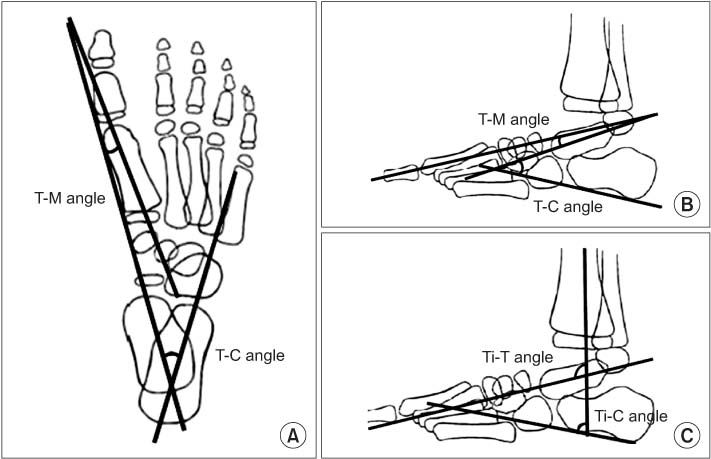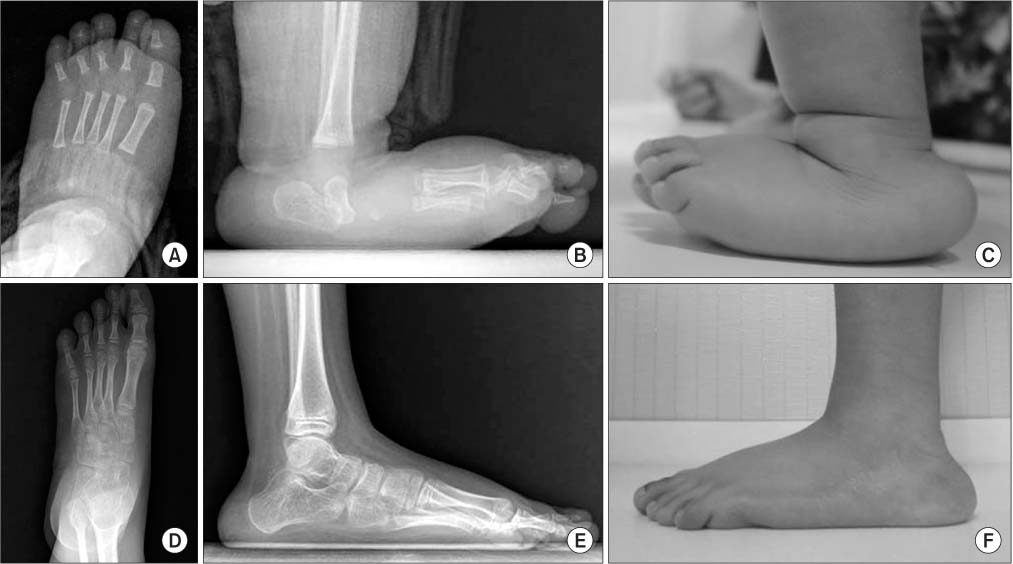J Korean Orthop Assoc.
2015 Oct;50(5):394-400. 10.4055/jkoa.2015.50.5.394.
Results of Surgical Treatment for Congenital Vertical Talus
- Affiliations
-
- 1Department of Orthopedic Surgery, Pusan National University Hospital, Pusan National University School of Medicine, Busan, Korea. kimht@pusan.ac.kr
- KMID: 2185102
- DOI: http://doi.org/10.4055/jkoa.2015.50.5.394
Abstract
- PURPOSE
We performed clinical and radiological evaluation of surgical outcomes of congenital vertical talus.
MATERIALS AND METHODS
Fifteen surgically treated feet in 9 patients (6 bilateral and 3 unilateral) which were followed-up for at least 2 years were included. Mean patient age at the time of surgery was 10.9 months. The surgical technique was a one-stage correction using the Kumar technique with a Cincinnati skin incision. In 7 feet we also transferred half of the tibialis anterior to the talar neck (the Grice technique). Radiologic parameters (talo-calcaneal angle, talo-first metatarsal angle, tibio-talar angle, tibio-calcaneal angle) were analyzed pre- and postoperatively and at the last follow-up, and clinical outcomes by the Laaveg-Ponseti score.
RESULTS
Talus orientation was improved in all patients. All radiologic parameters showed statistically significant improvement by the last follow-up. The mean Laaveg-Ponseti score at the last follow-up was 16 for patient satisfaction, 16 for function, and 24 for pain. There was no recurrence, however one case of talar neck fracture occurred during the tibialis anterior transfer.
CONCLUSION
One-stage surgical correction for congenital vertical talus at an early age provides satisfactory functional and cosmetic results.
Figure
Reference
-
1. Becker-Andersen H, Reimann I. Congenital vertical talus. Reevaluation of early manipulative treatment. Acta Orthop Scand. 1974; 45:130–144.2. Dobbs MB, Purcell DB, Nunley R, Morcuende JA. Early results of a new method of treatment for idiopathic congenital vertical talus. J Bone Joint Surg Am. 2006; 88:1192–1200.3. Alaee F, Boehm S, Dobbs MB. A new approach to the treatment of congenital vertical talus. J Child Orthop. 2007; 1:165–174.4. Choi IH, Chung CY, Cho TJ, Yoo WJ, Park MS. Duk Yong Lee's pediatric orthopaedics. 4th ed. Seoul: Koonja;2014. p. 517–521.5. Kumar SJ, Cowell HR, Ramsey PL. Vertical and oblique talus. Instr Course Lect. 1982; 31:235–251.6. Colton CL. The surgical management of congenital vertical talus. J Bone Joint Surg Br. 1973; 55:566–574.7. Grice DS. An extra-articular arthrodesis of the subastragalar joint for correction of paralytic flat feet in children. J Bone Joint Surg Am. 1952; 34:927–940.8. Coleman SS, Stelling FH 3rd, Jarrett J. Pathomechanics and treatment of congenital vertical talus. Clin Orthop Relat Res. 1970; 70:62–72.9. Lakshmanan P, Phillips SJ, Thomas RH, O'Doherty DP. Partial wound closure of the Cincinnati incision in clubfoot correction. Eur J Orthop Surg Traumatol. 2005; 15:28–31.10. Grice DS. The role of subtalar fusion in the treatment of valgus deformities of the feet. Instr Course Lect. 1959; 16:127–150.11. Laaveg SJ, Ponseti IV. Long-term results of treatment of congenital club foot. J Bone Joint Surg Am. 1980; 62:23–31.12. Lamy L, Weissman L. Congenital convex pes valgus. J Bone Joint Surg Am. 1939; 21:79–91.13. Osmond-Clarke H. Congenital vertical talus. J Bone Joint Surg Br. 1956; 38:334–341.14. Lloyd-Roberts GC, Spence AJ. Congenital vertical talus. J Bone Joint Surg Br. 1958; 40:33–41.15. Eyre-Brook AL. Congenital vertical talus. J Bone Joint Surg Br. 1967; 49:618–627.16. Dodge LD, Ashley RK, Gilbert RJ. Treatment of the congenital vertical talus: a retrospective review of 36 feet with long-term follow-up. Foot Ankle. 1987; 7:326–332.17. Sharrard WJ, Grosfield I. The management of deformity and paralysis of the foot in myelomeningocele. J Bone Joint Surg Br. 1968; 50:456–465.18. Wirth T, Schuler P, Griss P. Early surgical treatment for congenital vertical talus. Arch Orthop Trauma Surg. 1994; 113:248–253.19. Harrold AJ. Congenital vertical talus in infancy. J Bone Joint Surg Br. 1967; 49:634–643.20. Drennan JC, Sharrard WJ. The pathological anatomy of convex pes valgus. J Bone Joint Surg Br. 1971; 53:455–461.21. Sharrard WJ. Paralytic deformity in the lower limb. J Bone Joint Surg Br. 1967; 49:731–747.22. Patterson WR, Fitz DA, Smith WS. The pathologic anatomy of congenital convex pes valgus. Post morten study of a newborn infant with bilateral involvement. J Bone Joint Surg Am. 1968; 50:458–466.23. Vanderwilde R, Staheli LT, Chew DE, Malagon V. Measurements on radiographs of the foot in normal infants and children. J Bone Joint Surg Am. 1988; 70:407–415.
- Full Text Links
- Actions
-
Cited
- CITED
-
- Close
- Share
- Similar articles
-
- Congenital Vertical Talus: Report of a Case
- Untreated Congenital Vertical Talus Associated with Tarsal Codlition: A Case Report
- Congenital Vertical Talus Treated with Kumar Operation
- Surgical Treatment in Congenital Ulnar Drift of Fingers
- Redomicrofracture as a Treatment for Osteochondral Lesion of Talus after the Failure of Arthroscopic Microfracture



